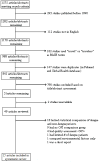Clinical and laboratory features that distinguish dengue from other febrile illnesses in endemic populations
- PMID: 18803612
- PMCID: PMC2756447
- DOI: 10.1111/j.1365-3156.2008.02151.x
Clinical and laboratory features that distinguish dengue from other febrile illnesses in endemic populations
Abstract
Objective: Clinicians in resource-poor countries need to identify patients with dengue using readily-available data. The objective of this systematic review was to identify clinical and laboratory features that differentiate dengue fever (DF) and/or dengue haemorrhagic fever (DHF) from other febrile illnesses (OFI) in dengue-endemic populations.
Method: Systematic review of the literature from 1990 to 30 October 2007 including English publications comparing dengue and OFI.
Results: Among 49 studies reviewed, 34 did not meet our criteria for inclusion. Of the 15 studies included, 10 were prospective cohort studies and five were case-control studies. Seven studies assessed all ages, four assessed children only, and four assessed adults only. Patients with dengue had significantly lower platelet, white blood cell (WBC) and neutrophil counts, and a higher frequency of petechiae than OFI patients. Higher frequencies of myalgia, rash, haemorrhagic signs, lethargy/prostration, and arthralgia/joint pain and higher haematocrits were reported in adult patients with dengue but not in children. Most multivariable models included platelet count, WBC, rash, and signs of liver damage; however, none had high statistical validity and none considered changes in clinical features over the course of illness.
Conclusions: Several individual clinical and laboratory variables distinguish dengue from OFI; however, some variables may be dependent on age. No published multivariable model has been validated. Study design, populations, diagnostic criteria, and data collection methods differed widely across studies, and the majority of studies did not identify specific aetiologies of OFIs. More prospective studies are needed to construct a valid and generalizable algorithm to guide the differential diagnosis of dengue in endemic countries.
References
-
- Ageep AK, Malik AA, Elkarsani MS. Clinical presentations and laboratory findings in suspected cases of dengue virus. Saudi Med J. 2006;27:1711–1713. - PubMed
-
- Akram DS, Igarashi A, Takasu T. Dengue virus infection among children with undifferentiated fever in Karachi. Indian J Pediatr. 1998;65:735–740. - PubMed
-
- Ali N, Nadeem A, Anwar M, Tariq WU, Chotani RA. Dengue fever in malaria endemic areas. J Coll Physicians Surg Pak. 2006;16:340–342. - PubMed
-
- Anuradha S, Singh NP, Rizvi SN, Agarwal SK, Gur R, Mathur MD. The 1996 outbreak of dengue hemorrhagic fever in Delhi, India. Southeast Asian J Trop Med Public Health. 1998;29:503–506. - PubMed
-
- Ashford DA, Savage HM, Hajjeh RA, et al. Outbreak of dengue fever in Palau, Western Pacific: risk factors for infection. Am J Trop Med Hyg. 2003;69:135–140. - PubMed
Publication types
MeSH terms
Substances
Grants and funding
LinkOut - more resources
Full Text Sources
Other Literature Sources
Medical
Molecular Biology Databases
Miscellaneous


